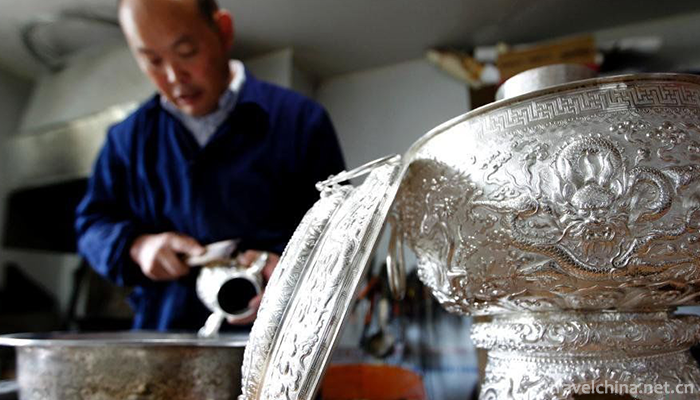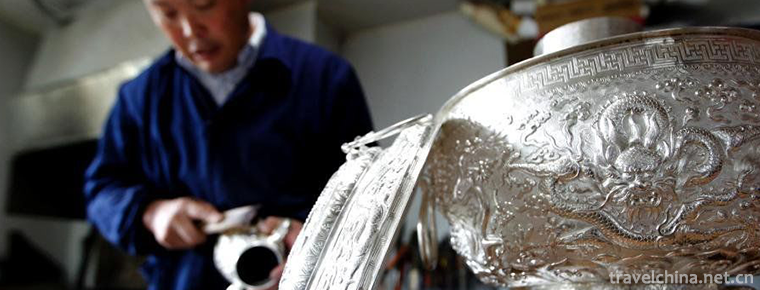Silver and Copper Ware Making and Gold smelting Techniques
Silver and Copper Ware Making and Gold-smelting Techniques
Silver and bronze wares production and gold mincing skills, local traditional skills in Huangzhong County, Qinghai Province, one of the national intangible cultural heritage.
Silver and bronze ware production and gold smelting process is complex. Silver and bronze ware production process includes cutting, welding, smashing, gluing, composition, polishing and so on. Gold smearing process includes gold smearing, gold smearing, gold opening, calendering and so on, and finally forms a silver and bronze ware work.
On May 23, 2011, the production of silver and bronze wares and the skills of bronzing gold were approved by the State Council of the People's Republic of China and listed in the third batch of national intangible cultural heritage catalogue, item number_-196.
historical origin
Silver and bronze ware making and bronzing technology is the processing technology of silver and bronze ware in Huangzhong. This technology has a long history of more than 100 years. It can be divided into two kinds of processing technology: silver and bronze ware. Silver processing technology is known for its thin, bright, gentle and pure shape. It is well known for its exquisite processing and is deeply loved by people of all nationalities. Influenced by Buddhist culture, artists often use "eight auspicious emblems" (umbrella, goldfish, vase, victory building, Falun, auspicious knot, right-handed conch, Miaolian) and mandala, miraculous wing bird, dragon, phoenix, lion, monster, auspicious cloud, Baoyan and other decorative patterns. There are more than 30 processing workshops in Huangzhong County. They represent artists'life expectancy (provincial level arts and crafts artists), He Man, He Yun and so on.
Technological characteristics
Huangzhong Silver and Copper Wares can be divided into Silver Wares and Copper Wares Processing Products. They all have the artistic characteristics of Tibetan culture. Silver products have fine craftsmanship, rich patterns, complex shapes and unique expressive techniques. Huangzhong Silver Ware has a long history of several hundred years. It is famous for its thin, bright, soft and pure shape. It is well known for its exquisite processing and is deeply loved by people of all nationalities. There are many kinds of silver wares, such as silver teapot, silver tea cover, silver tea saucer, silver wooden bowl, braid, earrings, necklaces, bracelets, etc. There are also monastery suppliers, small meridian wheel, water purifying kettle, water supply kettle and other instruments, such as suona, insertion of wings, snails and other musical instruments are exquisite, with high aesthetic value. Influenced by Buddhist culture, artists often use "eight auspicious emblems" (goldfish, vase, victory building, Falun, auspicious knot, right-handed conch, Miaolian) and mandala, miraculous winged bird, dragon, phoenix, lion, monster, auspicious cloud, Baoyan as decorative patterns. Copper ware has exquisite processing technology, complex patterns, lifelike shapes and outstanding performance techniques. There are Buddha statues, lamps, water bowls and other monasteries and religious supplies; there are kettles, fire basins, incense burners (the bottom often has the word "Daming Xuande". The founder thinks his level has reached the level of Xuande burner), incense cones (for perfuming), wax tables, lamps, hand stoves and other religious and civilian supplies.
Gold smelting technology was invented in ancient China. The method is to cut the gold foil about a millimeter thick and put it in a crucible to heat it to 400 C, then put it in mercury (mercury). The ratio of gold to mercury is 1:7. After mixing, it is poured into water to form "gold sludge". Gold stick is dipped in "gold mud" and brushed repeatedly on bronze ware. Finally, the bronze ware surface is baked with hot charcoal to evaporate mercury. Gold remains on the bronze ware surface and becomes a golden bronze ware.
Technological process
The processing technology of silver and copper wares is relatively complex, with complex patterns, realistic shapes and prominent expressive techniques. The main process is: blanking - Welding - smashing - glue - Composition - polishing. The production mode of silver and bronze wares in Huangzhong is mainly handicraft workshop. The son inherits his father's business and passes it on from generation to generation. Its representative artists include Qinghai Province's third-class craftsmen, such as Fengfu, Li Zhanbang, and more than 40 workshops.
Gold smelting is also a kind of metal processing technology, also known as "gold coating", "gold plating" and "flowing gold". It is a technology that gold and mercury are synthesized by gold and mercury, which are coated on the surface of silver and copper wares. The mercury is evaporated by heating, and the gold is firmly attached to the surface of silver and copper wares without falling off. Its technological process includes: shaking gold, smearing gold, opening gold, calendering. Silver bronze gold smelting technology is generally a family technology, with confidentiality.
Inheritance and Protection
Inheritance value
Silver and bronze wares making and bronzing techniques can be divided into silver and bronze processing techniques, exquisite processing techniques, novel and lively patterns, fine and ingenious workmanship, with strong Tibetan cultural characteristics and high aesthetic value and collection value.
Current situation of inheritance
Owing to the production of silver and bronze wares in Huangzhong and the skill of bronzing gold, the production mode of bronze wares in Huangzhong is generally based on the family handicraft workshop. The children inherit their father's business and pass on from generation to generation. In principle, they do not pass on their surnames. In addition, the objective reasons and facts of complex technology, high technical difficulty, long training time from apprentices to skilled craftsmen, slow production of products, large investment and slow effectiveness. In addition, many young people do not attach enough importance to the processing of silver and bronze ware, give up learning this craft, and the old artists die one after another, which makes the handicraft practitioners less, and brings adverse effects on the inheritance and promotion of the processing technology of silver and bronze ware. It is urgent to take effective measures to protect and inherit it.
Heritage figures
He Man, male, was born in April 1965. In December 2012, He Man was selected as the representative successor of the fourth batch of national intangible cultural heritage projects. He Man declared the items in Huangzhong County, Xining City, Qinghai Province: silver and bronze wares making and gold bronzing skills.
protective measures
In order to better protect and inherit the processing skills of silver and bronze wares in Huangzhong, the government departments of Huangzhong County have made great efforts to build the folk art brand of "eight-petal lotus flower", established the Silver and Bronze Ware Ware Ware Ware People's Association, and invested special funds to set up exhibition rooms, allocate plots to build platforms for unified creation, exhibition and sales, and also held various training courses regularly. Collecting and collating historical and cultural materials, recording and video recording, and protecting them through the above measures.
social influence
Important Exhibitions
In September 2015, at the City Fair, the heir He Man produced various silver and bronze wares on the spot.
Honorary recognition
Many handicraft works such as "Eight-petal Lotus Respect", "One Pot of Pure Silver", "Pure Silver Incense Burner" and "Auspicious Eight-treasure Dragon-pattern Silver-clad Wooden Bowl" created by the successor He Man have been collected by the National Museum of China and the China Arts and Crafts Museum.


-
2.Longchang Shipaifang Tourist Area
Located in Longchang City, Sichuan Province, China, Longchang Stone Memorial Architecture is a very important type of traditional Chinese architecture. It was rated as a class 4A tourist attraction by
Time 2019-02-06 -
3.Luzhi Ancient town
Yongzhi Ancient Town belongs to Wuzhong District of Suzhou City. It is located in the east of Suzhou City. It is 18 kilometers west of Suzhou City and 58 kilometers east of Shanghai.
Time 2019-02-06 -
4.The Great Wall Site of Qin Dynasty in Ningxia
The site of the Great Wall of King Zhao of Qin Dynasty was built in the twenty-fifth year of King Zhaoxiang of Qin Dynasty (272 BC). It was built to defend against the invasion of the Huns in the sout
Time 2019-02-07 -
5.Xishan Scenic Spot Suzhou
Xishan is the abbreviation of Xidongting Mountain. It is 11 kilometers wide in North and south, 15 kilometers long in East and west, and 79.8 square kilometers in area.
Time 2019-02-25 -
6.Zhenfoshan Scenic Spot
Zhenfoshan Scenic Spot, National AAAA Class Tourist Scenic Spot, Provincial Scenic Spot and Provincial Key Cultural Relics Protection Unit are the "Three Religious Holy Places" integrating B
Time 2019-03-17 -
7.Brodo
Buyi Opera, a local traditional drama in Ceheng County, Guizhou Province, is one of the national intangible cultural heritage.
Time 2019-04-04 -
8.Southwest Medical University
Southwest Medical University is an ordinary university in Sichuan Province. It is located in Luzhou, a famous historical and cultural city and a civilized city in the region of Sichuan, Yunnan, Guizho
Time 2019-08-31 -
9.Scrambled eggs with green peppers
Fried eggs with green peppers is a family dish. The main ingredients are eggs and green peppers. The auxiliary ingredients are lard, salt, vinegar, onion, etc. the main cooking technology is fried, ye
Time 2020-04-10 -
10.Neijiang traffic
Neijiang has convenient transportation, which is one of the main national highway transportation hubs planned by the Ministry of transport, the second largest transportation hub in Sichuan Province and an important intersection point of Southwest land
Time 2020-12-16 -
11.Leshan social service
By the end of 2018, there were 13 social welfare homes in Leshan City with 2908 beds and 2182 people in the hospital. The sales of social welfare lottery tickets totaled 385.69 million yuan, raised 109.75 million yuan of welfare lottery public welfare fund,
Time 2020-12-17 -
12.Animal resources in Guangan
There are 14 families, 30 species of mammals, 11 orders, 36 families, 115 species of birds, 19 species of reptiles and 10 species of frogs in Guang'an City. The national first-class protected birds include the Tragopan, which is mainly distributed in the forest area of H
Time 2020-12-19